Holmes Institute HI5017: Managerial Accounting Report
VerifiedAdded on 2022/10/17
|13
|3840
|327
Report
AI Summary
This report critically evaluates the purpose and use of management accounting systems (MAS) in supporting business managers' decision-making processes. It examines two selected journal articles, illustrating the importance of MAS techniques such as Activity Based Costing (ABC), Just in Time (JIT), and Balanced Scorecard (BSC), in providing relevant operational information for effective strategy development and business growth. The report analyzes a case study of a multinational manufacturing company and compares its findings with another journal article on the adoption of MAS. It emphasizes the necessity of strategic analysis before selecting an appropriate MAS to ensure it aligns with operational needs. The report also details four specific outcomes and lessons learned from each article, pertinent to Australian management accountants, highlighting the practical implications of MAS in a competitive environment. The analysis underscores the significance of tailoring MAS implementation to the specific strategic needs and internal environment of a company for optimal effectiveness.
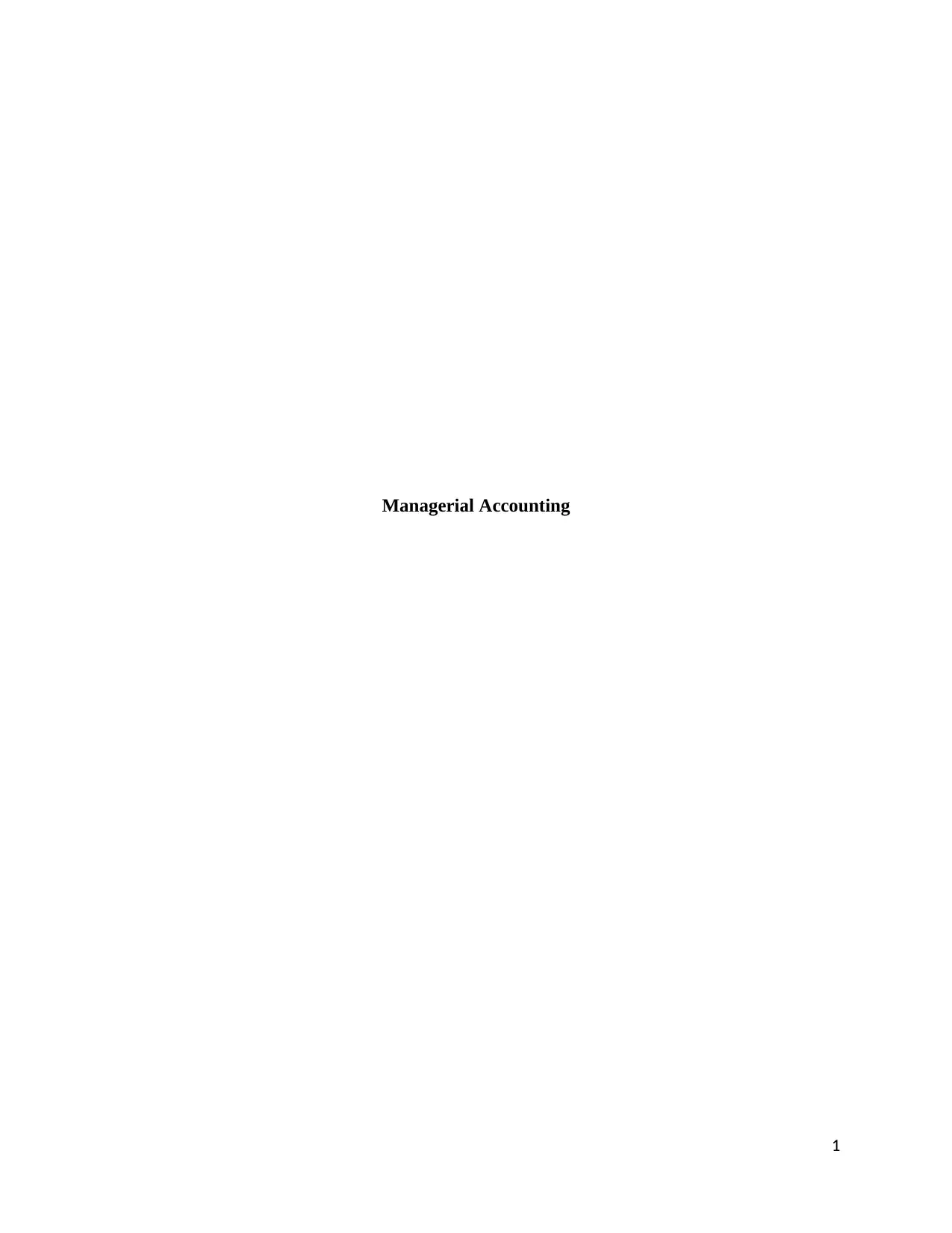
Managerial Accounting
1
1
Paraphrase This Document
Need a fresh take? Get an instant paraphrase of this document with our AI Paraphraser
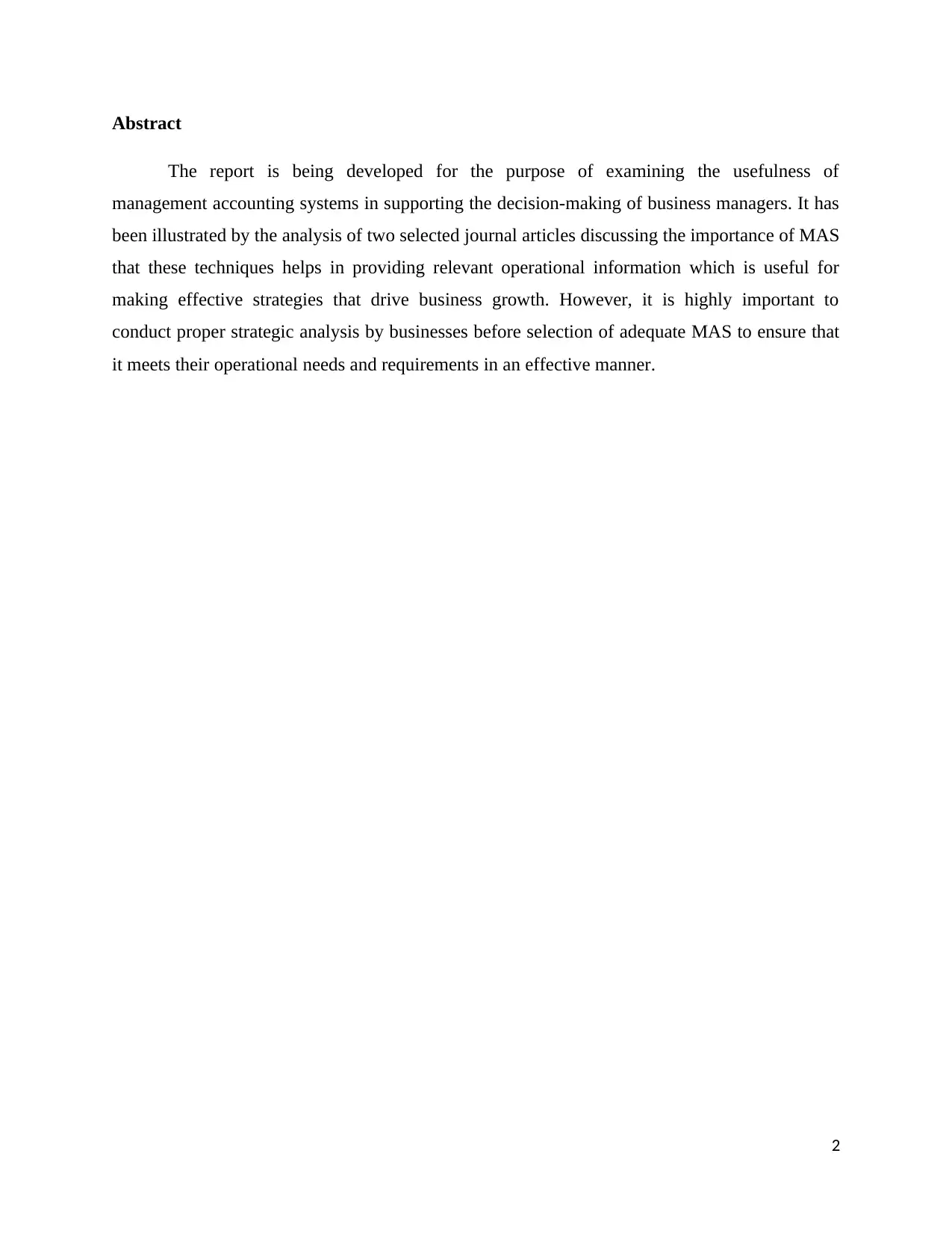
Abstract
The report is being developed for the purpose of examining the usefulness of
management accounting systems in supporting the decision-making of business managers. It has
been illustrated by the analysis of two selected journal articles discussing the importance of MAS
that these techniques helps in providing relevant operational information which is useful for
making effective strategies that drive business growth. However, it is highly important to
conduct proper strategic analysis by businesses before selection of adequate MAS to ensure that
it meets their operational needs and requirements in an effective manner.
2
The report is being developed for the purpose of examining the usefulness of
management accounting systems in supporting the decision-making of business managers. It has
been illustrated by the analysis of two selected journal articles discussing the importance of MAS
that these techniques helps in providing relevant operational information which is useful for
making effective strategies that drive business growth. However, it is highly important to
conduct proper strategic analysis by businesses before selection of adequate MAS to ensure that
it meets their operational needs and requirements in an effective manner.
2
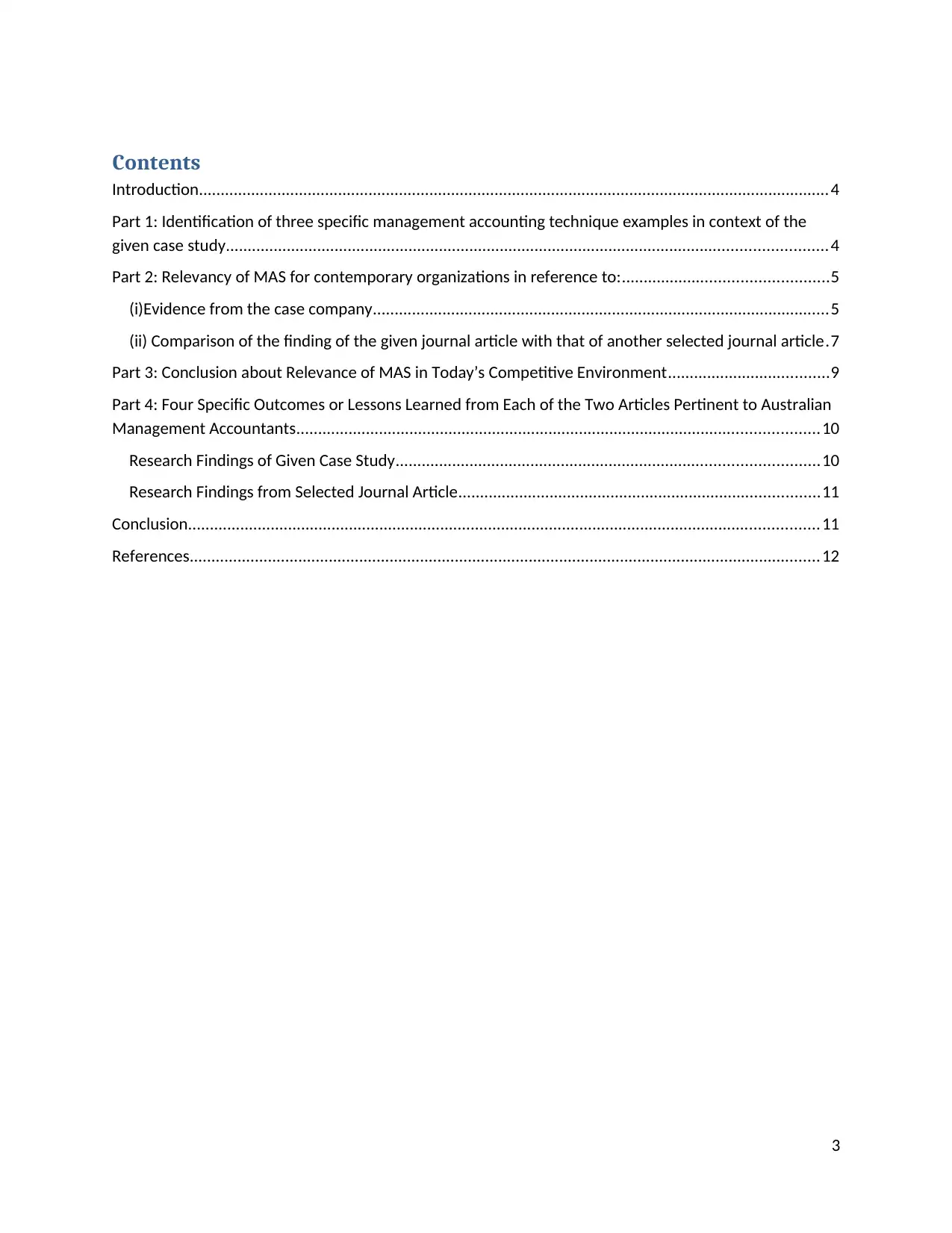
Contents
Introduction.................................................................................................................................................4
Part 1: Identification of three specific management accounting technique examples in context of the
given case study..........................................................................................................................................4
Part 2: Relevancy of MAS for contemporary organizations in reference to:...............................................5
(i)Evidence from the case company.........................................................................................................5
(ii) Comparison of the finding of the given journal article with that of another selected journal article.7
Part 3: Conclusion about Relevance of MAS in Today’s Competitive Environment.....................................9
Part 4: Four Specific Outcomes or Lessons Learned from Each of the Two Articles Pertinent to Australian
Management Accountants........................................................................................................................10
Research Findings of Given Case Study.................................................................................................10
Research Findings from Selected Journal Article...................................................................................11
Conclusion.................................................................................................................................................11
References.................................................................................................................................................12
3
Introduction.................................................................................................................................................4
Part 1: Identification of three specific management accounting technique examples in context of the
given case study..........................................................................................................................................4
Part 2: Relevancy of MAS for contemporary organizations in reference to:...............................................5
(i)Evidence from the case company.........................................................................................................5
(ii) Comparison of the finding of the given journal article with that of another selected journal article.7
Part 3: Conclusion about Relevance of MAS in Today’s Competitive Environment.....................................9
Part 4: Four Specific Outcomes or Lessons Learned from Each of the Two Articles Pertinent to Australian
Management Accountants........................................................................................................................10
Research Findings of Given Case Study.................................................................................................10
Research Findings from Selected Journal Article...................................................................................11
Conclusion.................................................................................................................................................11
References.................................................................................................................................................12
3
⊘ This is a preview!⊘
Do you want full access?
Subscribe today to unlock all pages.

Trusted by 1+ million students worldwide
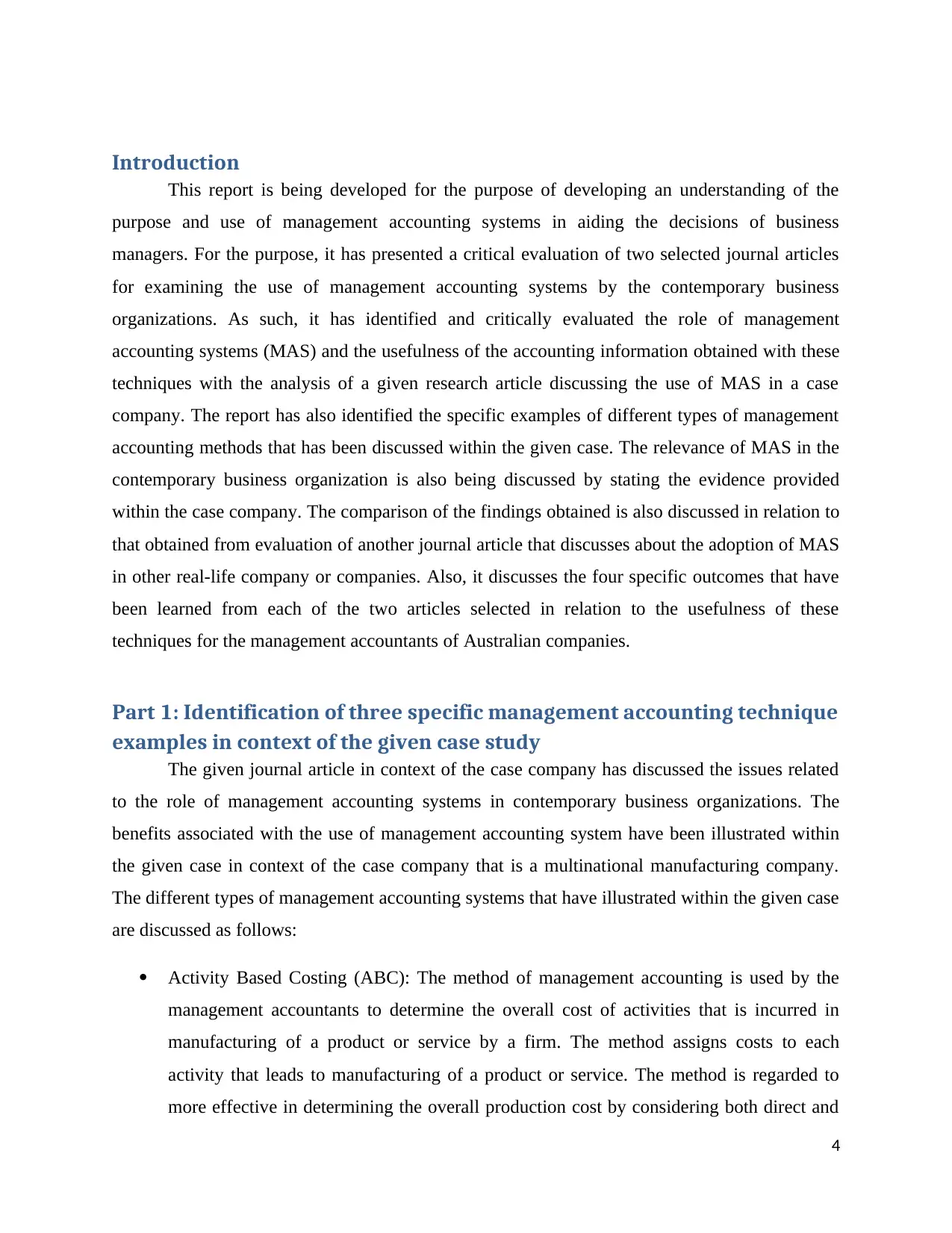
Introduction
This report is being developed for the purpose of developing an understanding of the
purpose and use of management accounting systems in aiding the decisions of business
managers. For the purpose, it has presented a critical evaluation of two selected journal articles
for examining the use of management accounting systems by the contemporary business
organizations. As such, it has identified and critically evaluated the role of management
accounting systems (MAS) and the usefulness of the accounting information obtained with these
techniques with the analysis of a given research article discussing the use of MAS in a case
company. The report has also identified the specific examples of different types of management
accounting methods that has been discussed within the given case. The relevance of MAS in the
contemporary business organization is also being discussed by stating the evidence provided
within the case company. The comparison of the findings obtained is also discussed in relation to
that obtained from evaluation of another journal article that discusses about the adoption of MAS
in other real-life company or companies. Also, it discusses the four specific outcomes that have
been learned from each of the two articles selected in relation to the usefulness of these
techniques for the management accountants of Australian companies.
Part 1: Identification of three specific management accounting technique
examples in context of the given case study
The given journal article in context of the case company has discussed the issues related
to the role of management accounting systems in contemporary business organizations. The
benefits associated with the use of management accounting system have been illustrated within
the given case in context of the case company that is a multinational manufacturing company.
The different types of management accounting systems that have illustrated within the given case
are discussed as follows:
Activity Based Costing (ABC): The method of management accounting is used by the
management accountants to determine the overall cost of activities that is incurred in
manufacturing of a product or service by a firm. The method assigns costs to each
activity that leads to manufacturing of a product or service. The method is regarded to
more effective in determining the overall production cost by considering both direct and
4
This report is being developed for the purpose of developing an understanding of the
purpose and use of management accounting systems in aiding the decisions of business
managers. For the purpose, it has presented a critical evaluation of two selected journal articles
for examining the use of management accounting systems by the contemporary business
organizations. As such, it has identified and critically evaluated the role of management
accounting systems (MAS) and the usefulness of the accounting information obtained with these
techniques with the analysis of a given research article discussing the use of MAS in a case
company. The report has also identified the specific examples of different types of management
accounting methods that has been discussed within the given case. The relevance of MAS in the
contemporary business organization is also being discussed by stating the evidence provided
within the case company. The comparison of the findings obtained is also discussed in relation to
that obtained from evaluation of another journal article that discusses about the adoption of MAS
in other real-life company or companies. Also, it discusses the four specific outcomes that have
been learned from each of the two articles selected in relation to the usefulness of these
techniques for the management accountants of Australian companies.
Part 1: Identification of three specific management accounting technique
examples in context of the given case study
The given journal article in context of the case company has discussed the issues related
to the role of management accounting systems in contemporary business organizations. The
benefits associated with the use of management accounting system have been illustrated within
the given case in context of the case company that is a multinational manufacturing company.
The different types of management accounting systems that have illustrated within the given case
are discussed as follows:
Activity Based Costing (ABC): The method of management accounting is used by the
management accountants to determine the overall cost of activities that is incurred in
manufacturing of a product or service by a firm. The method assigns costs to each
activity that leads to manufacturing of a product or service. The method is regarded to
more effective in determining the overall production cost by considering both direct and
4
Paraphrase This Document
Need a fresh take? Get an instant paraphrase of this document with our AI Paraphraser
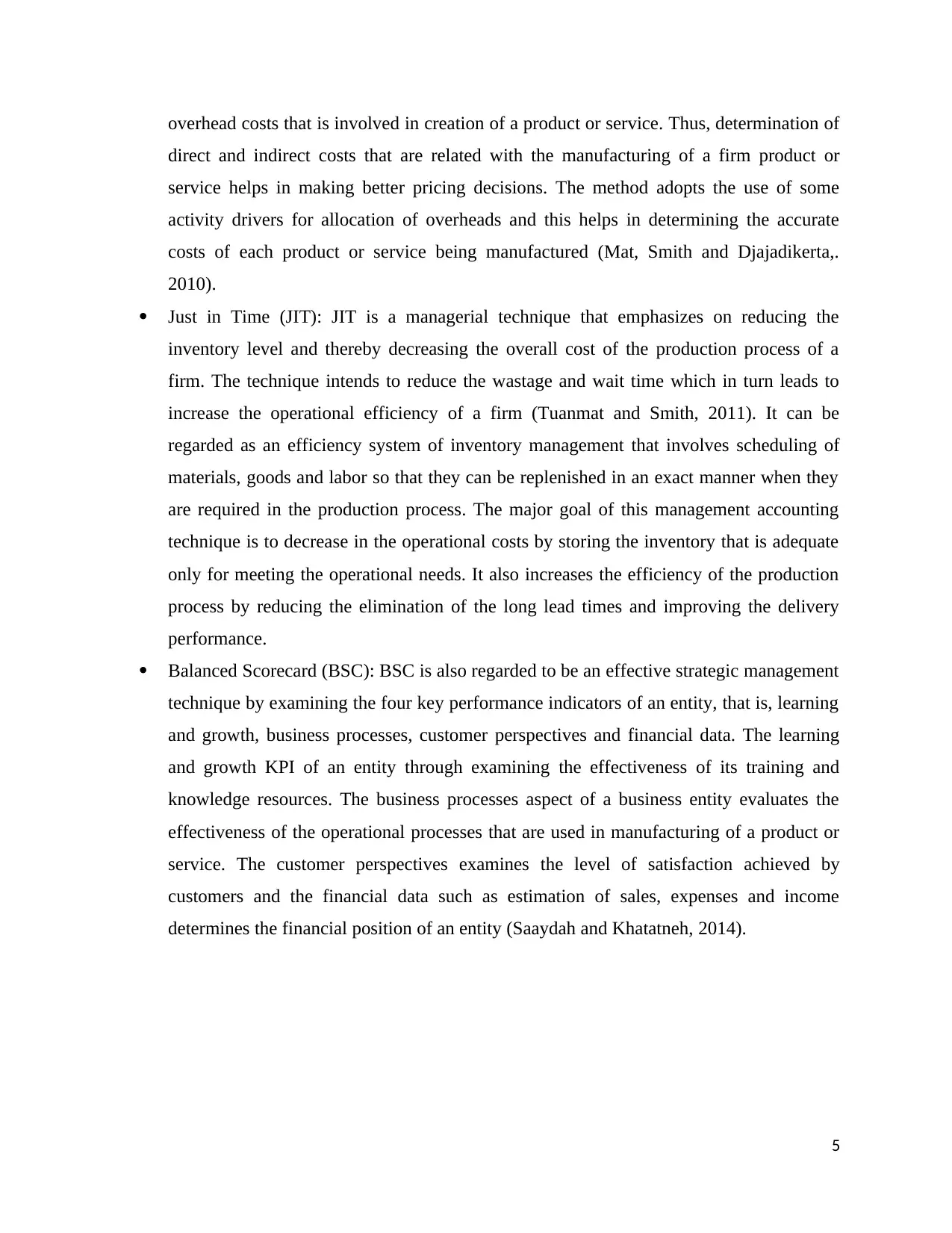
overhead costs that is involved in creation of a product or service. Thus, determination of
direct and indirect costs that are related with the manufacturing of a firm product or
service helps in making better pricing decisions. The method adopts the use of some
activity drivers for allocation of overheads and this helps in determining the accurate
costs of each product or service being manufactured (Mat, Smith and Djajadikerta,.
2010).
Just in Time (JIT): JIT is a managerial technique that emphasizes on reducing the
inventory level and thereby decreasing the overall cost of the production process of a
firm. The technique intends to reduce the wastage and wait time which in turn leads to
increase the operational efficiency of a firm (Tuanmat and Smith, 2011). It can be
regarded as an efficiency system of inventory management that involves scheduling of
materials, goods and labor so that they can be replenished in an exact manner when they
are required in the production process. The major goal of this management accounting
technique is to decrease in the operational costs by storing the inventory that is adequate
only for meeting the operational needs. It also increases the efficiency of the production
process by reducing the elimination of the long lead times and improving the delivery
performance.
Balanced Scorecard (BSC): BSC is also regarded to be an effective strategic management
technique by examining the four key performance indicators of an entity, that is, learning
and growth, business processes, customer perspectives and financial data. The learning
and growth KPI of an entity through examining the effectiveness of its training and
knowledge resources. The business processes aspect of a business entity evaluates the
effectiveness of the operational processes that are used in manufacturing of a product or
service. The customer perspectives examines the level of satisfaction achieved by
customers and the financial data such as estimation of sales, expenses and income
determines the financial position of an entity (Saaydah and Khatatneh, 2014).
5
direct and indirect costs that are related with the manufacturing of a firm product or
service helps in making better pricing decisions. The method adopts the use of some
activity drivers for allocation of overheads and this helps in determining the accurate
costs of each product or service being manufactured (Mat, Smith and Djajadikerta,.
2010).
Just in Time (JIT): JIT is a managerial technique that emphasizes on reducing the
inventory level and thereby decreasing the overall cost of the production process of a
firm. The technique intends to reduce the wastage and wait time which in turn leads to
increase the operational efficiency of a firm (Tuanmat and Smith, 2011). It can be
regarded as an efficiency system of inventory management that involves scheduling of
materials, goods and labor so that they can be replenished in an exact manner when they
are required in the production process. The major goal of this management accounting
technique is to decrease in the operational costs by storing the inventory that is adequate
only for meeting the operational needs. It also increases the efficiency of the production
process by reducing the elimination of the long lead times and improving the delivery
performance.
Balanced Scorecard (BSC): BSC is also regarded to be an effective strategic management
technique by examining the four key performance indicators of an entity, that is, learning
and growth, business processes, customer perspectives and financial data. The learning
and growth KPI of an entity through examining the effectiveness of its training and
knowledge resources. The business processes aspect of a business entity evaluates the
effectiveness of the operational processes that are used in manufacturing of a product or
service. The customer perspectives examines the level of satisfaction achieved by
customers and the financial data such as estimation of sales, expenses and income
determines the financial position of an entity (Saaydah and Khatatneh, 2014).
5
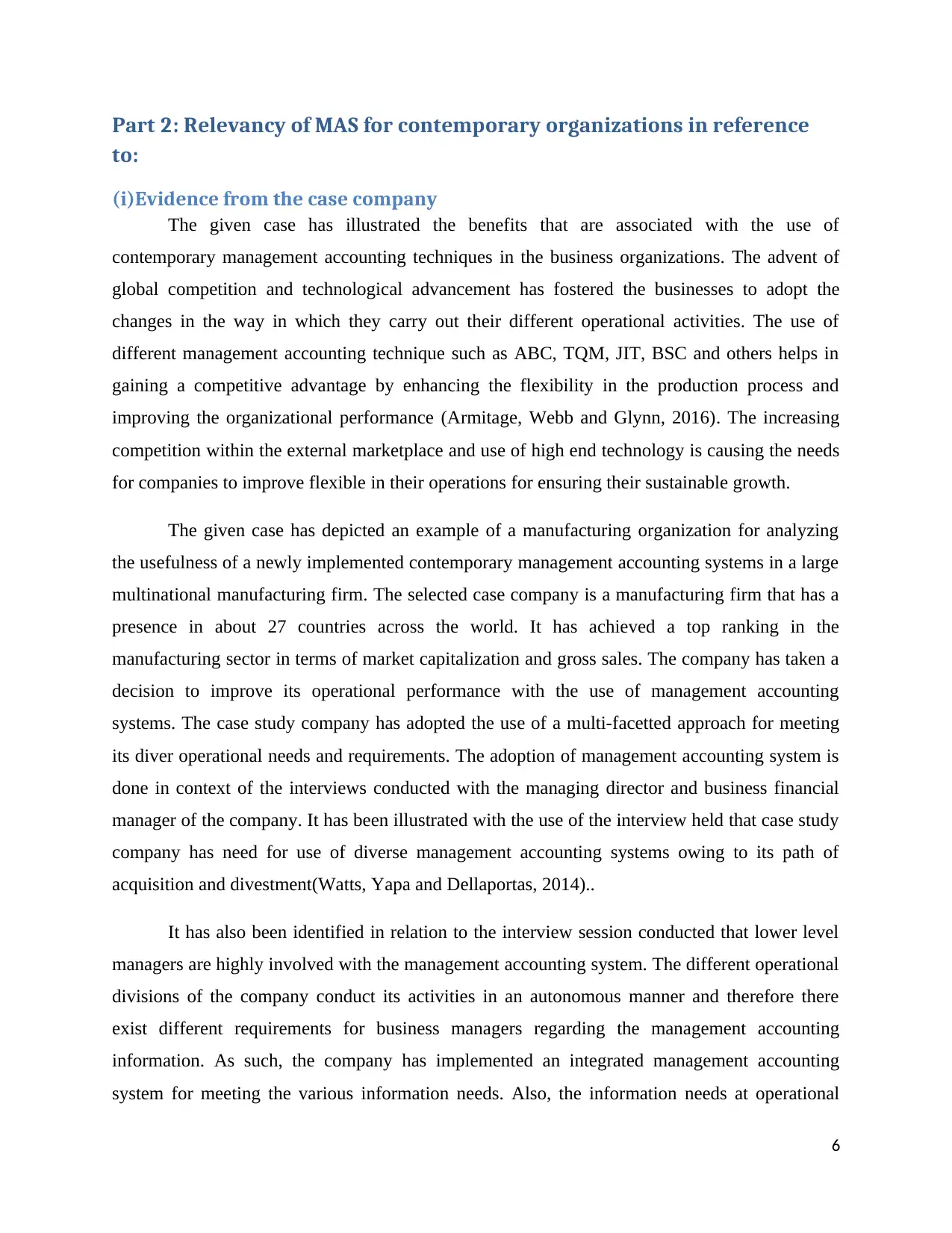
Part 2: Relevancy of MAS for contemporary organizations in reference
to:
(i)Evidence from the case company
The given case has illustrated the benefits that are associated with the use of
contemporary management accounting techniques in the business organizations. The advent of
global competition and technological advancement has fostered the businesses to adopt the
changes in the way in which they carry out their different operational activities. The use of
different management accounting technique such as ABC, TQM, JIT, BSC and others helps in
gaining a competitive advantage by enhancing the flexibility in the production process and
improving the organizational performance (Armitage, Webb and Glynn, 2016). The increasing
competition within the external marketplace and use of high end technology is causing the needs
for companies to improve flexible in their operations for ensuring their sustainable growth.
The given case has depicted an example of a manufacturing organization for analyzing
the usefulness of a newly implemented contemporary management accounting systems in a large
multinational manufacturing firm. The selected case company is a manufacturing firm that has a
presence in about 27 countries across the world. It has achieved a top ranking in the
manufacturing sector in terms of market capitalization and gross sales. The company has taken a
decision to improve its operational performance with the use of management accounting
systems. The case study company has adopted the use of a multi-facetted approach for meeting
its diver operational needs and requirements. The adoption of management accounting system is
done in context of the interviews conducted with the managing director and business financial
manager of the company. It has been illustrated with the use of the interview held that case study
company has need for use of diverse management accounting systems owing to its path of
acquisition and divestment(Watts, Yapa and Dellaportas, 2014)..
It has also been identified in relation to the interview session conducted that lower level
managers are highly involved with the management accounting system. The different operational
divisions of the company conduct its activities in an autonomous manner and therefore there
exist different requirements for business managers regarding the management accounting
information. As such, the company has implemented an integrated management accounting
system for meeting the various information needs. Also, the information needs at operational
6
to:
(i)Evidence from the case company
The given case has illustrated the benefits that are associated with the use of
contemporary management accounting techniques in the business organizations. The advent of
global competition and technological advancement has fostered the businesses to adopt the
changes in the way in which they carry out their different operational activities. The use of
different management accounting technique such as ABC, TQM, JIT, BSC and others helps in
gaining a competitive advantage by enhancing the flexibility in the production process and
improving the organizational performance (Armitage, Webb and Glynn, 2016). The increasing
competition within the external marketplace and use of high end technology is causing the needs
for companies to improve flexible in their operations for ensuring their sustainable growth.
The given case has depicted an example of a manufacturing organization for analyzing
the usefulness of a newly implemented contemporary management accounting systems in a large
multinational manufacturing firm. The selected case company is a manufacturing firm that has a
presence in about 27 countries across the world. It has achieved a top ranking in the
manufacturing sector in terms of market capitalization and gross sales. The company has taken a
decision to improve its operational performance with the use of management accounting
systems. The case study company has adopted the use of a multi-facetted approach for meeting
its diver operational needs and requirements. The adoption of management accounting system is
done in context of the interviews conducted with the managing director and business financial
manager of the company. It has been illustrated with the use of the interview held that case study
company has need for use of diverse management accounting systems owing to its path of
acquisition and divestment(Watts, Yapa and Dellaportas, 2014)..
It has also been identified in relation to the interview session conducted that lower level
managers are highly involved with the management accounting system. The different operational
divisions of the company conduct its activities in an autonomous manner and therefore there
exist different requirements for business managers regarding the management accounting
information. As such, the company has implemented an integrated management accounting
system for meeting the various information needs. Also, the information needs at operational
6
⊘ This is a preview!⊘
Do you want full access?
Subscribe today to unlock all pages.

Trusted by 1+ million students worldwide
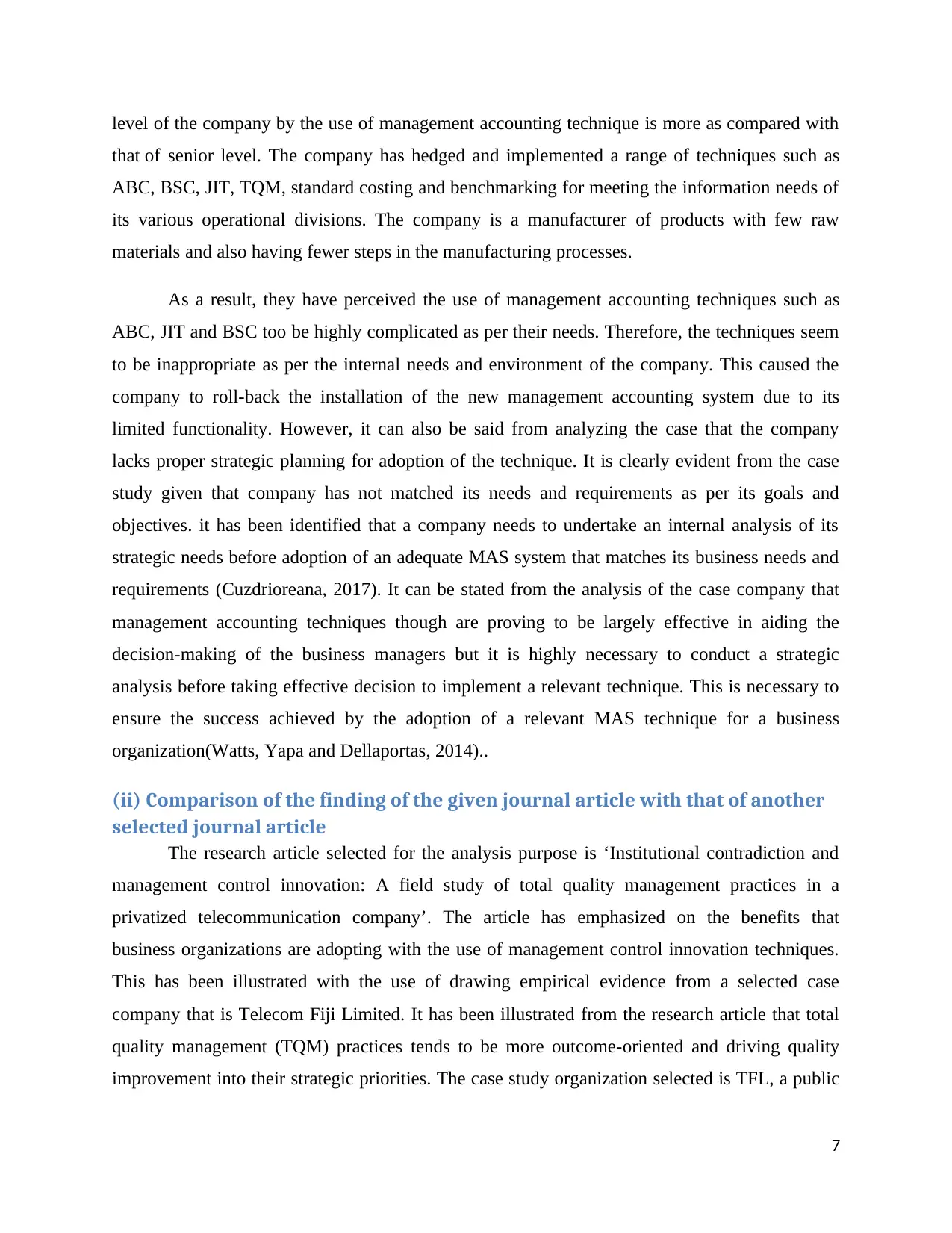
level of the company by the use of management accounting technique is more as compared with
that of senior level. The company has hedged and implemented a range of techniques such as
ABC, BSC, JIT, TQM, standard costing and benchmarking for meeting the information needs of
its various operational divisions. The company is a manufacturer of products with few raw
materials and also having fewer steps in the manufacturing processes.
As a result, they have perceived the use of management accounting techniques such as
ABC, JIT and BSC too be highly complicated as per their needs. Therefore, the techniques seem
to be inappropriate as per the internal needs and environment of the company. This caused the
company to roll-back the installation of the new management accounting system due to its
limited functionality. However, it can also be said from analyzing the case that the company
lacks proper strategic planning for adoption of the technique. It is clearly evident from the case
study given that company has not matched its needs and requirements as per its goals and
objectives. it has been identified that a company needs to undertake an internal analysis of its
strategic needs before adoption of an adequate MAS system that matches its business needs and
requirements (Cuzdrioreana, 2017). It can be stated from the analysis of the case company that
management accounting techniques though are proving to be largely effective in aiding the
decision-making of the business managers but it is highly necessary to conduct a strategic
analysis before taking effective decision to implement a relevant technique. This is necessary to
ensure the success achieved by the adoption of a relevant MAS technique for a business
organization(Watts, Yapa and Dellaportas, 2014)..
(ii) Comparison of the finding of the given journal article with that of another
selected journal article
The research article selected for the analysis purpose is ‘Institutional contradiction and
management control innovation: A field study of total quality management practices in a
privatized telecommunication company’. The article has emphasized on the benefits that
business organizations are adopting with the use of management control innovation techniques.
This has been illustrated with the use of drawing empirical evidence from a selected case
company that is Telecom Fiji Limited. It has been illustrated from the research article that total
quality management (TQM) practices tends to be more outcome-oriented and driving quality
improvement into their strategic priorities. The case study organization selected is TFL, a public
7
that of senior level. The company has hedged and implemented a range of techniques such as
ABC, BSC, JIT, TQM, standard costing and benchmarking for meeting the information needs of
its various operational divisions. The company is a manufacturer of products with few raw
materials and also having fewer steps in the manufacturing processes.
As a result, they have perceived the use of management accounting techniques such as
ABC, JIT and BSC too be highly complicated as per their needs. Therefore, the techniques seem
to be inappropriate as per the internal needs and environment of the company. This caused the
company to roll-back the installation of the new management accounting system due to its
limited functionality. However, it can also be said from analyzing the case that the company
lacks proper strategic planning for adoption of the technique. It is clearly evident from the case
study given that company has not matched its needs and requirements as per its goals and
objectives. it has been identified that a company needs to undertake an internal analysis of its
strategic needs before adoption of an adequate MAS system that matches its business needs and
requirements (Cuzdrioreana, 2017). It can be stated from the analysis of the case company that
management accounting techniques though are proving to be largely effective in aiding the
decision-making of the business managers but it is highly necessary to conduct a strategic
analysis before taking effective decision to implement a relevant technique. This is necessary to
ensure the success achieved by the adoption of a relevant MAS technique for a business
organization(Watts, Yapa and Dellaportas, 2014)..
(ii) Comparison of the finding of the given journal article with that of another
selected journal article
The research article selected for the analysis purpose is ‘Institutional contradiction and
management control innovation: A field study of total quality management practices in a
privatized telecommunication company’. The article has emphasized on the benefits that
business organizations are adopting with the use of management control innovation techniques.
This has been illustrated with the use of drawing empirical evidence from a selected case
company that is Telecom Fiji Limited. It has been illustrated from the research article that total
quality management (TQM) practices tends to be more outcome-oriented and driving quality
improvement into their strategic priorities. The case study organization selected is TFL, a public
7
Paraphrase This Document
Need a fresh take? Get an instant paraphrase of this document with our AI Paraphraser
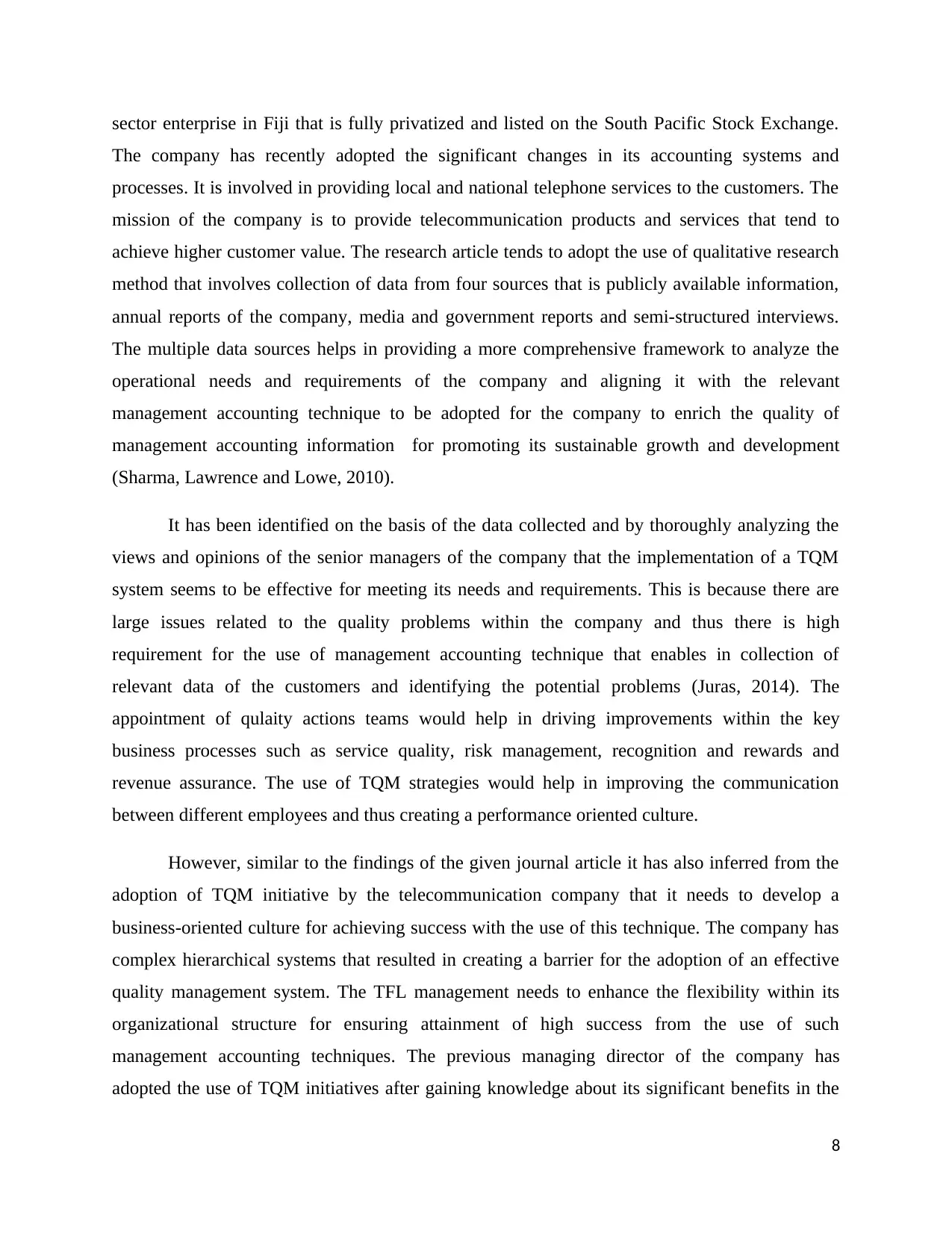
sector enterprise in Fiji that is fully privatized and listed on the South Pacific Stock Exchange.
The company has recently adopted the significant changes in its accounting systems and
processes. It is involved in providing local and national telephone services to the customers. The
mission of the company is to provide telecommunication products and services that tend to
achieve higher customer value. The research article tends to adopt the use of qualitative research
method that involves collection of data from four sources that is publicly available information,
annual reports of the company, media and government reports and semi-structured interviews.
The multiple data sources helps in providing a more comprehensive framework to analyze the
operational needs and requirements of the company and aligning it with the relevant
management accounting technique to be adopted for the company to enrich the quality of
management accounting information for promoting its sustainable growth and development
(Sharma, Lawrence and Lowe, 2010).
It has been identified on the basis of the data collected and by thoroughly analyzing the
views and opinions of the senior managers of the company that the implementation of a TQM
system seems to be effective for meeting its needs and requirements. This is because there are
large issues related to the quality problems within the company and thus there is high
requirement for the use of management accounting technique that enables in collection of
relevant data of the customers and identifying the potential problems (Juras, 2014). The
appointment of qulaity actions teams would help in driving improvements within the key
business processes such as service quality, risk management, recognition and rewards and
revenue assurance. The use of TQM strategies would help in improving the communication
between different employees and thus creating a performance oriented culture.
However, similar to the findings of the given journal article it has also inferred from the
adoption of TQM initiative by the telecommunication company that it needs to develop a
business-oriented culture for achieving success with the use of this technique. The company has
complex hierarchical systems that resulted in creating a barrier for the adoption of an effective
quality management system. The TFL management needs to enhance the flexibility within its
organizational structure for ensuring attainment of high success from the use of such
management accounting techniques. The previous managing director of the company has
adopted the use of TQM initiatives after gaining knowledge about its significant benefits in the
8
The company has recently adopted the significant changes in its accounting systems and
processes. It is involved in providing local and national telephone services to the customers. The
mission of the company is to provide telecommunication products and services that tend to
achieve higher customer value. The research article tends to adopt the use of qualitative research
method that involves collection of data from four sources that is publicly available information,
annual reports of the company, media and government reports and semi-structured interviews.
The multiple data sources helps in providing a more comprehensive framework to analyze the
operational needs and requirements of the company and aligning it with the relevant
management accounting technique to be adopted for the company to enrich the quality of
management accounting information for promoting its sustainable growth and development
(Sharma, Lawrence and Lowe, 2010).
It has been identified on the basis of the data collected and by thoroughly analyzing the
views and opinions of the senior managers of the company that the implementation of a TQM
system seems to be effective for meeting its needs and requirements. This is because there are
large issues related to the quality problems within the company and thus there is high
requirement for the use of management accounting technique that enables in collection of
relevant data of the customers and identifying the potential problems (Juras, 2014). The
appointment of qulaity actions teams would help in driving improvements within the key
business processes such as service quality, risk management, recognition and rewards and
revenue assurance. The use of TQM strategies would help in improving the communication
between different employees and thus creating a performance oriented culture.
However, similar to the findings of the given journal article it has also inferred from the
adoption of TQM initiative by the telecommunication company that it needs to develop a
business-oriented culture for achieving success with the use of this technique. The company has
complex hierarchical systems that resulted in creating a barrier for the adoption of an effective
quality management system. The TFL management needs to enhance the flexibility within its
organizational structure for ensuring attainment of high success from the use of such
management accounting techniques. The previous managing director of the company has
adopted the use of TQM initiatives after gaining knowledge about its significant benefits in the
8
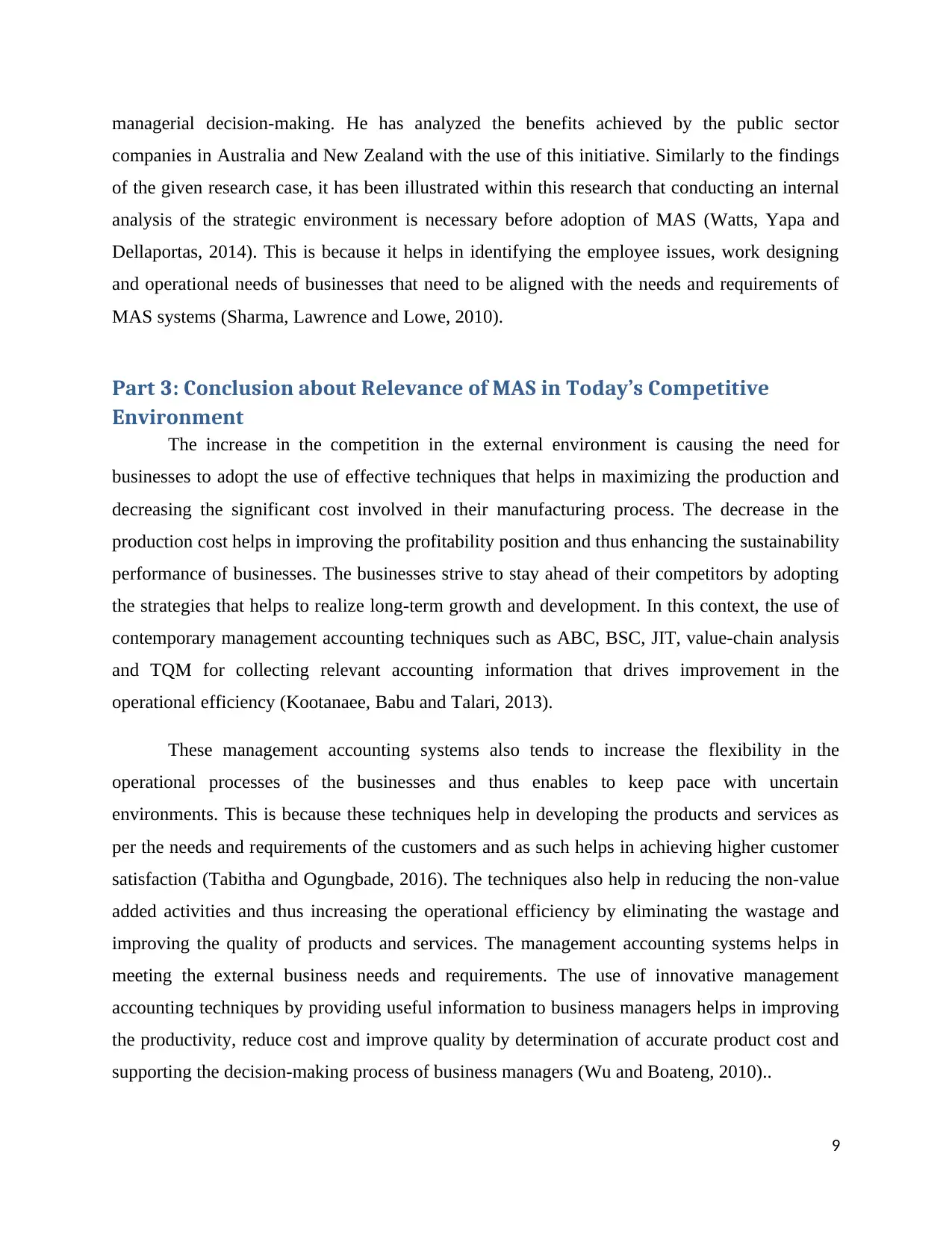
managerial decision-making. He has analyzed the benefits achieved by the public sector
companies in Australia and New Zealand with the use of this initiative. Similarly to the findings
of the given research case, it has been illustrated within this research that conducting an internal
analysis of the strategic environment is necessary before adoption of MAS (Watts, Yapa and
Dellaportas, 2014). This is because it helps in identifying the employee issues, work designing
and operational needs of businesses that need to be aligned with the needs and requirements of
MAS systems (Sharma, Lawrence and Lowe, 2010).
Part 3: Conclusion about Relevance of MAS in Today’s Competitive
Environment
The increase in the competition in the external environment is causing the need for
businesses to adopt the use of effective techniques that helps in maximizing the production and
decreasing the significant cost involved in their manufacturing process. The decrease in the
production cost helps in improving the profitability position and thus enhancing the sustainability
performance of businesses. The businesses strive to stay ahead of their competitors by adopting
the strategies that helps to realize long-term growth and development. In this context, the use of
contemporary management accounting techniques such as ABC, BSC, JIT, value-chain analysis
and TQM for collecting relevant accounting information that drives improvement in the
operational efficiency (Kootanaee, Babu and Talari, 2013).
These management accounting systems also tends to increase the flexibility in the
operational processes of the businesses and thus enables to keep pace with uncertain
environments. This is because these techniques help in developing the products and services as
per the needs and requirements of the customers and as such helps in achieving higher customer
satisfaction (Tabitha and Ogungbade, 2016). The techniques also help in reducing the non-value
added activities and thus increasing the operational efficiency by eliminating the wastage and
improving the quality of products and services. The management accounting systems helps in
meeting the external business needs and requirements. The use of innovative management
accounting techniques by providing useful information to business managers helps in improving
the productivity, reduce cost and improve quality by determination of accurate product cost and
supporting the decision-making process of business managers (Wu and Boateng, 2010)..
9
companies in Australia and New Zealand with the use of this initiative. Similarly to the findings
of the given research case, it has been illustrated within this research that conducting an internal
analysis of the strategic environment is necessary before adoption of MAS (Watts, Yapa and
Dellaportas, 2014). This is because it helps in identifying the employee issues, work designing
and operational needs of businesses that need to be aligned with the needs and requirements of
MAS systems (Sharma, Lawrence and Lowe, 2010).
Part 3: Conclusion about Relevance of MAS in Today’s Competitive
Environment
The increase in the competition in the external environment is causing the need for
businesses to adopt the use of effective techniques that helps in maximizing the production and
decreasing the significant cost involved in their manufacturing process. The decrease in the
production cost helps in improving the profitability position and thus enhancing the sustainability
performance of businesses. The businesses strive to stay ahead of their competitors by adopting
the strategies that helps to realize long-term growth and development. In this context, the use of
contemporary management accounting techniques such as ABC, BSC, JIT, value-chain analysis
and TQM for collecting relevant accounting information that drives improvement in the
operational efficiency (Kootanaee, Babu and Talari, 2013).
These management accounting systems also tends to increase the flexibility in the
operational processes of the businesses and thus enables to keep pace with uncertain
environments. This is because these techniques help in developing the products and services as
per the needs and requirements of the customers and as such helps in achieving higher customer
satisfaction (Tabitha and Ogungbade, 2016). The techniques also help in reducing the non-value
added activities and thus increasing the operational efficiency by eliminating the wastage and
improving the quality of products and services. The management accounting systems helps in
meeting the external business needs and requirements. The use of innovative management
accounting techniques by providing useful information to business managers helps in improving
the productivity, reduce cost and improve quality by determination of accurate product cost and
supporting the decision-making process of business managers (Wu and Boateng, 2010)..
9
⊘ This is a preview!⊘
Do you want full access?
Subscribe today to unlock all pages.

Trusted by 1+ million students worldwide
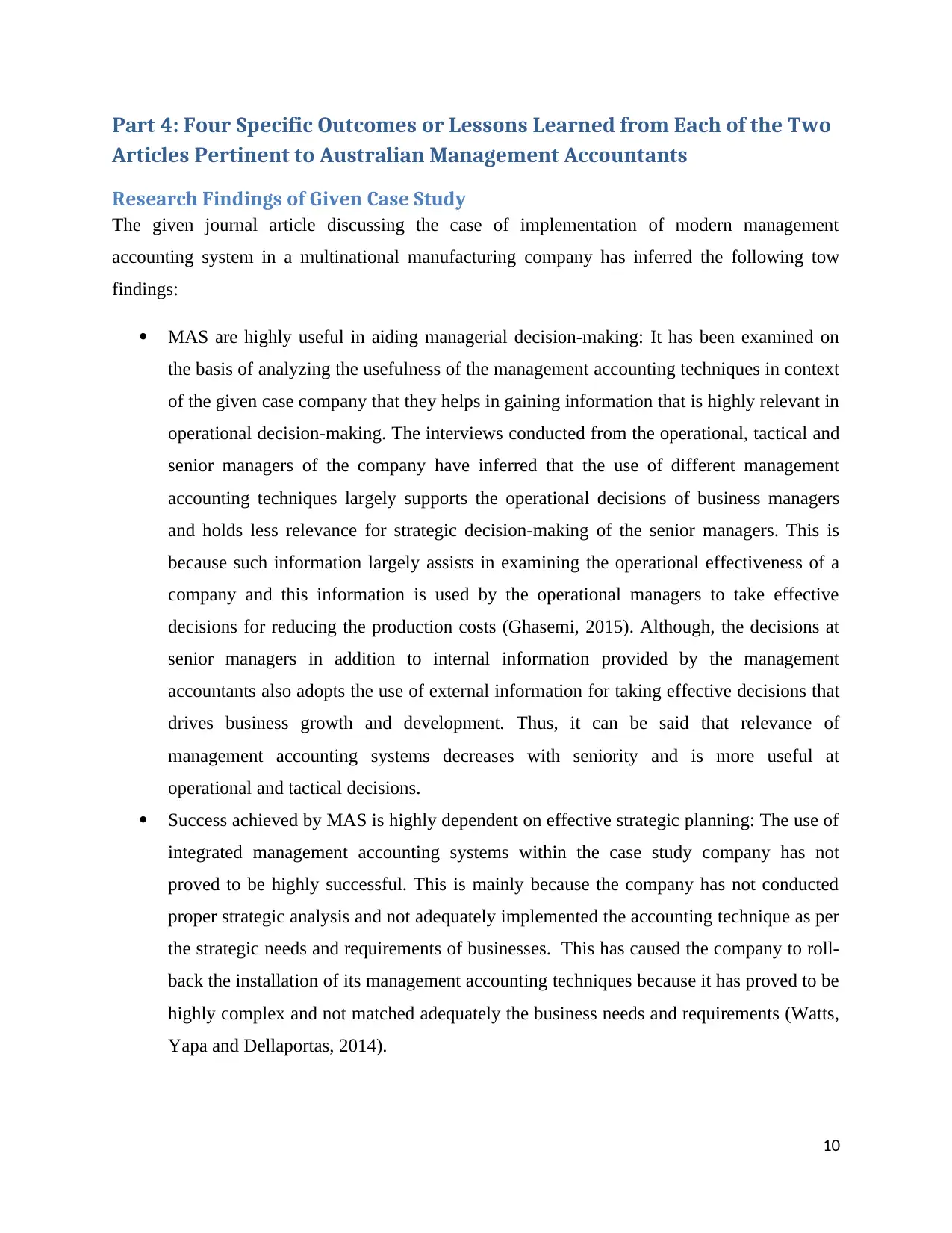
Part 4: Four Specific Outcomes or Lessons Learned from Each of the Two
Articles Pertinent to Australian Management Accountants
Research Findings of Given Case Study
The given journal article discussing the case of implementation of modern management
accounting system in a multinational manufacturing company has inferred the following tow
findings:
MAS are highly useful in aiding managerial decision-making: It has been examined on
the basis of analyzing the usefulness of the management accounting techniques in context
of the given case company that they helps in gaining information that is highly relevant in
operational decision-making. The interviews conducted from the operational, tactical and
senior managers of the company have inferred that the use of different management
accounting techniques largely supports the operational decisions of business managers
and holds less relevance for strategic decision-making of the senior managers. This is
because such information largely assists in examining the operational effectiveness of a
company and this information is used by the operational managers to take effective
decisions for reducing the production costs (Ghasemi, 2015). Although, the decisions at
senior managers in addition to internal information provided by the management
accountants also adopts the use of external information for taking effective decisions that
drives business growth and development. Thus, it can be said that relevance of
management accounting systems decreases with seniority and is more useful at
operational and tactical decisions.
Success achieved by MAS is highly dependent on effective strategic planning: The use of
integrated management accounting systems within the case study company has not
proved to be highly successful. This is mainly because the company has not conducted
proper strategic analysis and not adequately implemented the accounting technique as per
the strategic needs and requirements of businesses. This has caused the company to roll-
back the installation of its management accounting techniques because it has proved to be
highly complex and not matched adequately the business needs and requirements (Watts,
Yapa and Dellaportas, 2014).
10
Articles Pertinent to Australian Management Accountants
Research Findings of Given Case Study
The given journal article discussing the case of implementation of modern management
accounting system in a multinational manufacturing company has inferred the following tow
findings:
MAS are highly useful in aiding managerial decision-making: It has been examined on
the basis of analyzing the usefulness of the management accounting techniques in context
of the given case company that they helps in gaining information that is highly relevant in
operational decision-making. The interviews conducted from the operational, tactical and
senior managers of the company have inferred that the use of different management
accounting techniques largely supports the operational decisions of business managers
and holds less relevance for strategic decision-making of the senior managers. This is
because such information largely assists in examining the operational effectiveness of a
company and this information is used by the operational managers to take effective
decisions for reducing the production costs (Ghasemi, 2015). Although, the decisions at
senior managers in addition to internal information provided by the management
accountants also adopts the use of external information for taking effective decisions that
drives business growth and development. Thus, it can be said that relevance of
management accounting systems decreases with seniority and is more useful at
operational and tactical decisions.
Success achieved by MAS is highly dependent on effective strategic planning: The use of
integrated management accounting systems within the case study company has not
proved to be highly successful. This is mainly because the company has not conducted
proper strategic analysis and not adequately implemented the accounting technique as per
the strategic needs and requirements of businesses. This has caused the company to roll-
back the installation of its management accounting techniques because it has proved to be
highly complex and not matched adequately the business needs and requirements (Watts,
Yapa and Dellaportas, 2014).
10
Paraphrase This Document
Need a fresh take? Get an instant paraphrase of this document with our AI Paraphraser
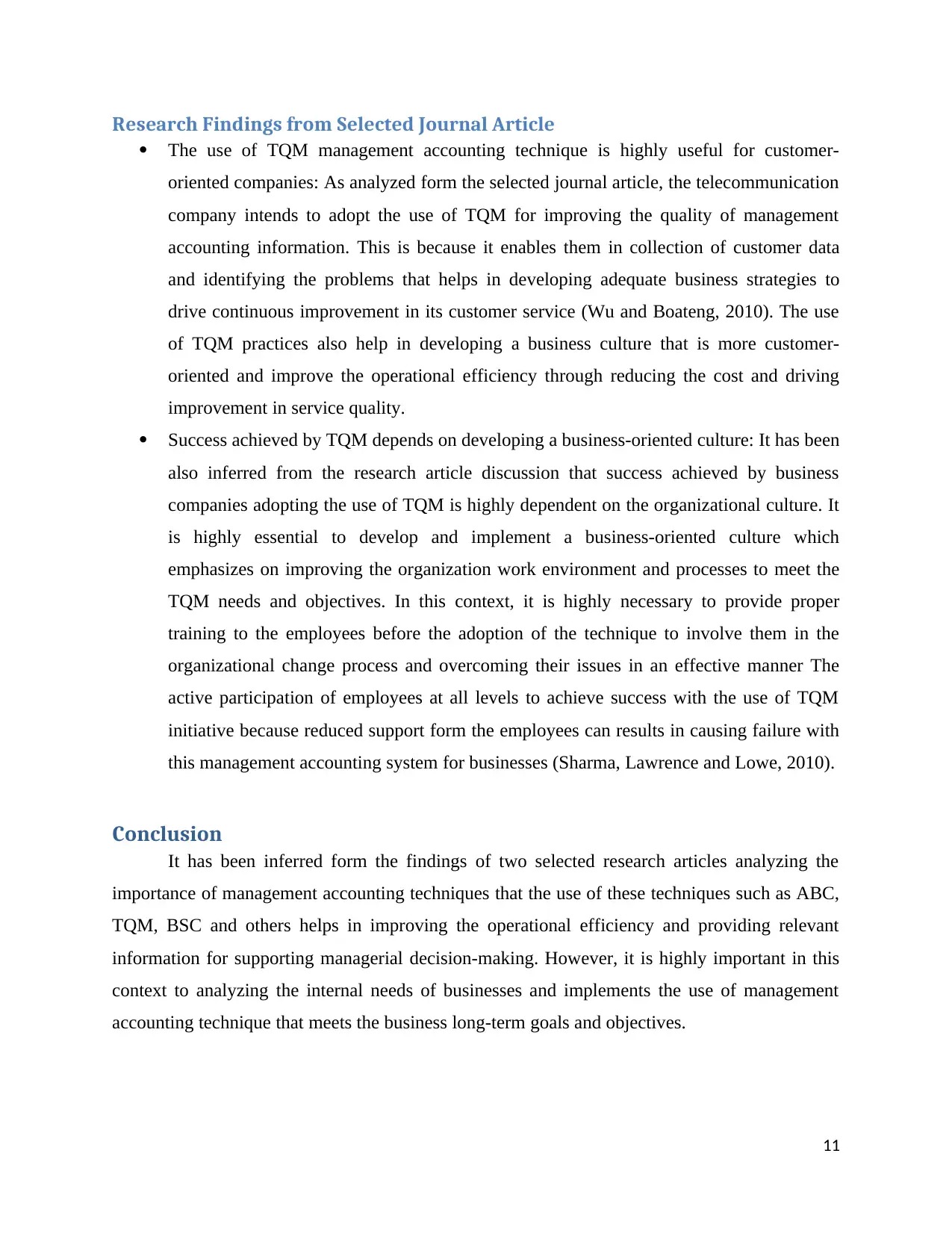
Research Findings from Selected Journal Article
The use of TQM management accounting technique is highly useful for customer-
oriented companies: As analyzed form the selected journal article, the telecommunication
company intends to adopt the use of TQM for improving the quality of management
accounting information. This is because it enables them in collection of customer data
and identifying the problems that helps in developing adequate business strategies to
drive continuous improvement in its customer service (Wu and Boateng, 2010). The use
of TQM practices also help in developing a business culture that is more customer-
oriented and improve the operational efficiency through reducing the cost and driving
improvement in service quality.
Success achieved by TQM depends on developing a business-oriented culture: It has been
also inferred from the research article discussion that success achieved by business
companies adopting the use of TQM is highly dependent on the organizational culture. It
is highly essential to develop and implement a business-oriented culture which
emphasizes on improving the organization work environment and processes to meet the
TQM needs and objectives. In this context, it is highly necessary to provide proper
training to the employees before the adoption of the technique to involve them in the
organizational change process and overcoming their issues in an effective manner The
active participation of employees at all levels to achieve success with the use of TQM
initiative because reduced support form the employees can results in causing failure with
this management accounting system for businesses (Sharma, Lawrence and Lowe, 2010).
Conclusion
It has been inferred form the findings of two selected research articles analyzing the
importance of management accounting techniques that the use of these techniques such as ABC,
TQM, BSC and others helps in improving the operational efficiency and providing relevant
information for supporting managerial decision-making. However, it is highly important in this
context to analyzing the internal needs of businesses and implements the use of management
accounting technique that meets the business long-term goals and objectives.
11
The use of TQM management accounting technique is highly useful for customer-
oriented companies: As analyzed form the selected journal article, the telecommunication
company intends to adopt the use of TQM for improving the quality of management
accounting information. This is because it enables them in collection of customer data
and identifying the problems that helps in developing adequate business strategies to
drive continuous improvement in its customer service (Wu and Boateng, 2010). The use
of TQM practices also help in developing a business culture that is more customer-
oriented and improve the operational efficiency through reducing the cost and driving
improvement in service quality.
Success achieved by TQM depends on developing a business-oriented culture: It has been
also inferred from the research article discussion that success achieved by business
companies adopting the use of TQM is highly dependent on the organizational culture. It
is highly essential to develop and implement a business-oriented culture which
emphasizes on improving the organization work environment and processes to meet the
TQM needs and objectives. In this context, it is highly necessary to provide proper
training to the employees before the adoption of the technique to involve them in the
organizational change process and overcoming their issues in an effective manner The
active participation of employees at all levels to achieve success with the use of TQM
initiative because reduced support form the employees can results in causing failure with
this management accounting system for businesses (Sharma, Lawrence and Lowe, 2010).
Conclusion
It has been inferred form the findings of two selected research articles analyzing the
importance of management accounting techniques that the use of these techniques such as ABC,
TQM, BSC and others helps in improving the operational efficiency and providing relevant
information for supporting managerial decision-making. However, it is highly important in this
context to analyzing the internal needs of businesses and implements the use of management
accounting technique that meets the business long-term goals and objectives.
11
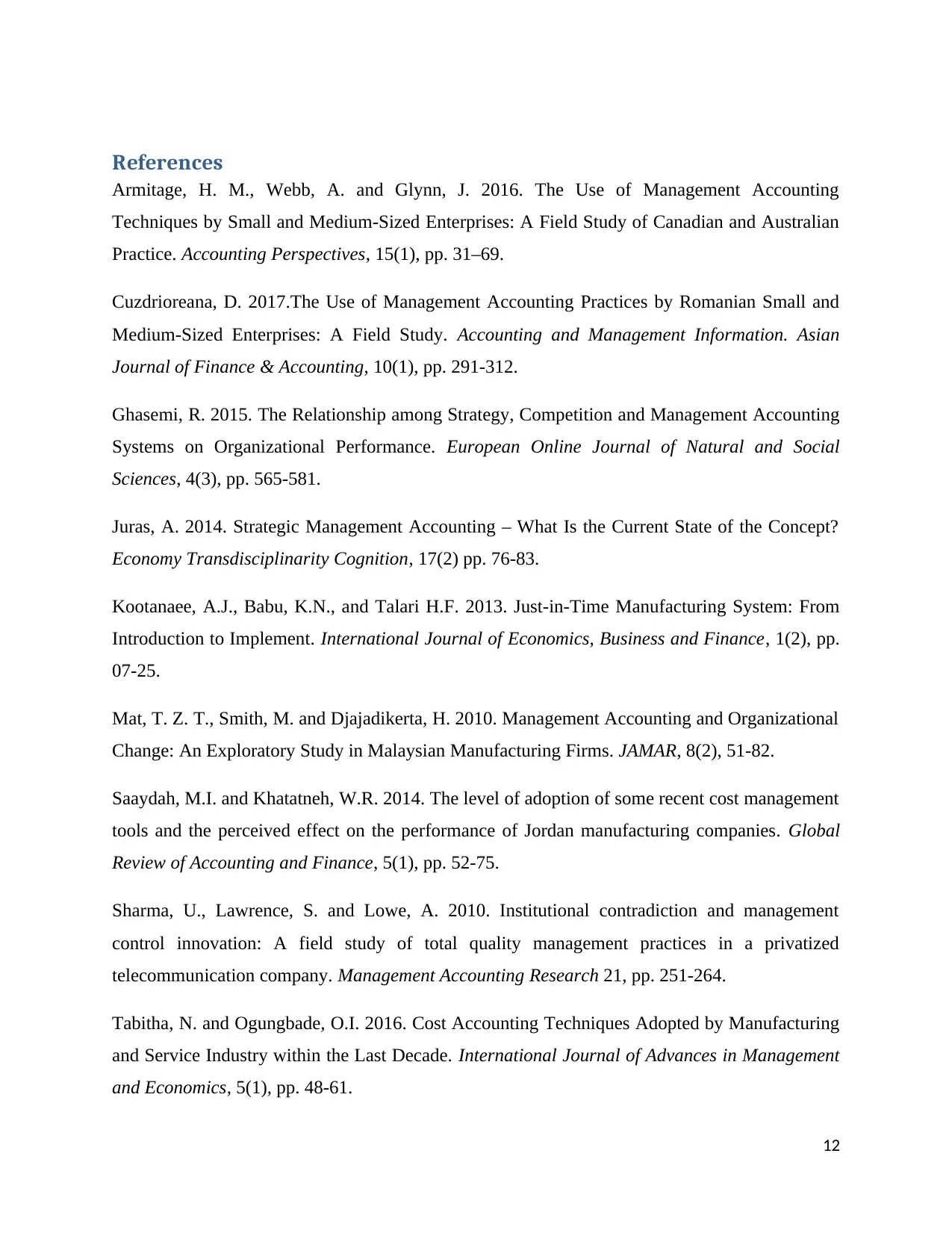
References
Armitage, H. M., Webb, A. and Glynn, J. 2016. The Use of Management Accounting
Techniques by Small and Medium‐Sized Enterprises: A Field Study of Canadian and Australian
Practice. Accounting Perspectives, 15(1), pp. 31–69.
Cuzdrioreana, D. 2017.The Use of Management Accounting Practices by Romanian Small and
Medium-Sized Enterprises: A Field Study. Accounting and Management Information. Asian
Journal of Finance & Accounting, 10(1), pp. 291-312.
Ghasemi, R. 2015. The Relationship among Strategy, Competition and Management Accounting
Systems on Organizational Performance. European Online Journal of Natural and Social
Sciences, 4(3), pp. 565-581.
Juras, A. 2014. Strategic Management Accounting – What Is the Current State of the Concept?
Economy Transdisciplinarity Cognition, 17(2) pp. 76-83.
Kootanaee, A.J., Babu, K.N., and Talari H.F. 2013. Just-in-Time Manufacturing System: From
Introduction to Implement. International Journal of Economics, Business and Finance, 1(2), pp.
07-25.
Mat, T. Z. T., Smith, M. and Djajadikerta, H. 2010. Management Accounting and Organizational
Change: An Exploratory Study in Malaysian Manufacturing Firms. JAMAR, 8(2), 51-82.
Saaydah, M.I. and Khatatneh, W.R. 2014. The level of adoption of some recent cost management
tools and the perceived effect on the performance of Jordan manufacturing companies. Global
Review of Accounting and Finance, 5(1), pp. 52-75.
Sharma, U., Lawrence, S. and Lowe, A. 2010. Institutional contradiction and management
control innovation: A field study of total quality management practices in a privatized
telecommunication company. Management Accounting Research 21, pp. 251-264.
Tabitha, N. and Ogungbade, O.I. 2016. Cost Accounting Techniques Adopted by Manufacturing
and Service Industry within the Last Decade. International Journal of Advances in Management
and Economics, 5(1), pp. 48-61.
12
Armitage, H. M., Webb, A. and Glynn, J. 2016. The Use of Management Accounting
Techniques by Small and Medium‐Sized Enterprises: A Field Study of Canadian and Australian
Practice. Accounting Perspectives, 15(1), pp. 31–69.
Cuzdrioreana, D. 2017.The Use of Management Accounting Practices by Romanian Small and
Medium-Sized Enterprises: A Field Study. Accounting and Management Information. Asian
Journal of Finance & Accounting, 10(1), pp. 291-312.
Ghasemi, R. 2015. The Relationship among Strategy, Competition and Management Accounting
Systems on Organizational Performance. European Online Journal of Natural and Social
Sciences, 4(3), pp. 565-581.
Juras, A. 2014. Strategic Management Accounting – What Is the Current State of the Concept?
Economy Transdisciplinarity Cognition, 17(2) pp. 76-83.
Kootanaee, A.J., Babu, K.N., and Talari H.F. 2013. Just-in-Time Manufacturing System: From
Introduction to Implement. International Journal of Economics, Business and Finance, 1(2), pp.
07-25.
Mat, T. Z. T., Smith, M. and Djajadikerta, H. 2010. Management Accounting and Organizational
Change: An Exploratory Study in Malaysian Manufacturing Firms. JAMAR, 8(2), 51-82.
Saaydah, M.I. and Khatatneh, W.R. 2014. The level of adoption of some recent cost management
tools and the perceived effect on the performance of Jordan manufacturing companies. Global
Review of Accounting and Finance, 5(1), pp. 52-75.
Sharma, U., Lawrence, S. and Lowe, A. 2010. Institutional contradiction and management
control innovation: A field study of total quality management practices in a privatized
telecommunication company. Management Accounting Research 21, pp. 251-264.
Tabitha, N. and Ogungbade, O.I. 2016. Cost Accounting Techniques Adopted by Manufacturing
and Service Industry within the Last Decade. International Journal of Advances in Management
and Economics, 5(1), pp. 48-61.
12
⊘ This is a preview!⊘
Do you want full access?
Subscribe today to unlock all pages.

Trusted by 1+ million students worldwide
1 out of 13
Related Documents
Your All-in-One AI-Powered Toolkit for Academic Success.
+13062052269
info@desklib.com
Available 24*7 on WhatsApp / Email
![[object Object]](/_next/static/media/star-bottom.7253800d.svg)
Unlock your academic potential
Copyright © 2020–2025 A2Z Services. All Rights Reserved. Developed and managed by ZUCOL.





